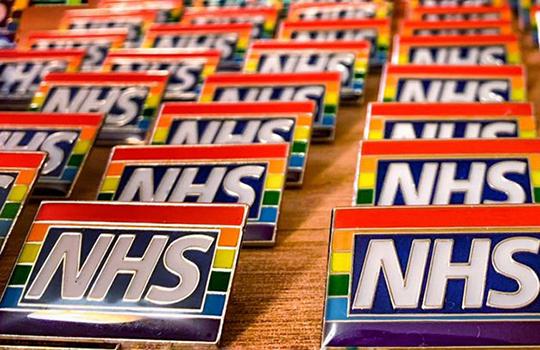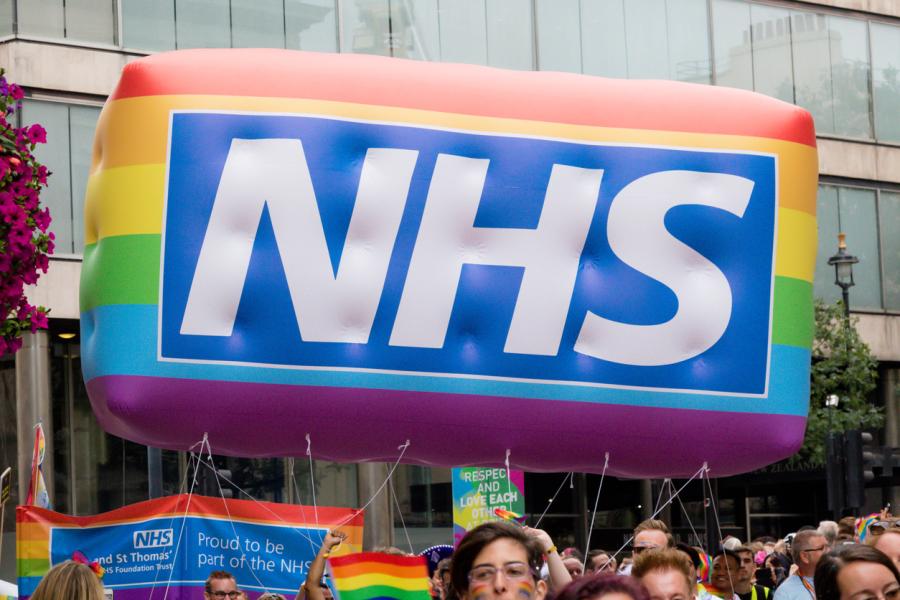Looking for Rainbows: Pride within the NHS

See a rainbow badge linked to the NHS and you might think it’s a sign of solidarity after a global pandemic. Look a little closer and you’ll see there’s a subtle difference between the coloured arcs hung in windows by children to those worn on lanyards. Six colourful lines in fact. And a different message of solidarity for the LGBTQ+ community.
Initially created as a pilot project at Evelina London to address some of the challenges LGBTQ+ young people can face when accessing NHS healthcare, Dr Mike Farquhar couldn’t predict the success of his concept: a little badge that carries a huge message across healthcare settings – both on the ground and through our TV screens. Our Young Reps put some questions to Dr Mike about the conception of this project and why it matters to young people with epilepsy:
What is the rainbow badge and why did you think there was a need for it?
The rainbow badge is a really simple idea, a strong signal to LGBTQ+ young people that NHS staff are there to support them. Without judgement or prejudice. Dr Mike explains ‘So that’s all it’s really meant to be. It’s about saying ‘I am somebody who you can feel confident that talking about these things is ok. I should be here to help you.’ The value of it is that it starts conversations that might otherwise not have happened.’
‘Why is it needed? Here’s an example, I’m a paediatrician but my job is sleep. I run a sleep clinic. On the face of it, if you were an LGBTQ+ teenager or a teenager who thinks they might be gay or trans, a sleep doctor might not seem the obvious first person to have the conversation with, so it sometimes just gives people the opportunity to have the conversations with people they might not have had. When you start to deconstruct it a little bit, one of the things that will absolutely affect everyone’s sleep in a bad way is stress, pressure and anxiety. So, if your day’s preoccupied with thinking ‘I think I’m gay and I can’t possibly talk to anyone about this’, that makes you anxious and stressed and worried. And when you’re anxious and stressed and worried you sleep less well, which can also affect your health, or trigger a seizure. So, when you have those conversations, you realise you don’t have a sleep problem, your problem is that you don’t have a good person to talk to about the things that really matter to you… That’s where the value comes in, in terms of why it’s important.’
Who wears the rainbow badge in the NHS?
‘The idea with the badge is that it’s a choice. We’re not forcing anyone to do this, it’s not compulsory in any shape or form, actually we don’t want people to feel pressured to wear it. We want people to choose to wear this badge …it has to be a positive choice
The second thing is that whoever decides to wear this has to acknowledge that it’s a responsibility. By wearing this badge it’s not just a pretty bit of bling that goes on your lanyard or uniform …We expect them to have done some background reading so they understand why it’s important and to sign a commitment to say ‘I understand the responsibility in wearing this’. We’re not expecting the people who wear the badges to have all the answers but we’re expecting them to listen, be non-judgemental, be supportive and if they feel between that they need more help then they know what the next step is.’
What do you think the impact has been?
‘There’s lots of differences between different groups of people. When we think about equality, diversity, inclusion work in particular, there’s this concept of protected characteristics so the kind of things that are different that we specifically think about where those people need more proactive support to address inequalities and prejudices.
Being LGBTQ+ can be a difference that’s not necessarily so obvious to people. When we start thinking about the impact, that starts to factor in. For example, if I went to hospital to get medical treatment and I saw people around me wearing the badges I might feel more relaxed and a lot more confident but I might never say or do anything to let those people know. The badge is just a very visible way to start a conversation. That I think is the most important thing.
The question of impact, the beginnings of this project was very much small scale, and very personally driven by a small number of people. The project has recently expanded to be run through NHS England into a much bigger project where we’re working on a whole range of initiatives to help improve healthcare for LGBTQ+ people. And one of the things that will be factored into that is a much more structured way of assessing impact and what the badge is achieving.’

As a young person with epilepsy, if I meet someone with a rainbow badge, what can I expect from them and what can I talk to them about?
‘The whole point is that it’s supposed to identify NHS staff who are good to talk to. We occasionally get young people who say ‘I love this can I wear one?’ but we have to say ‘no you can’t.’ That’s not us being horrible but, because the whole point of the project is to signify the member of NHS staff who is there to help you. So, if that dilutes out, that loses that message a little.
One of the most important things is that we know that it starts conversations that otherwise wouldn’t have happened and every single conversation is an opportunity to make things better. We’ve had lots of qualitative feedback from people saying, ‘well actually I find I stick this badge on and I’m suddenly having conversations about sexuality and gender identity that I’ve never had before. And it’s not that those conversations weren’t there to be had, it’s that there wasn’t that connection to get that going.’
As a young person with epilepsy, if I want to speak to my doctor about anything LGBTQ+ related, how would I go about that, and why is it important that I do?
'Taking the second bit first, why is it important to do it? It’s because as your paediatricians we should be here to help *you*, and not just to focus solely on your medical diagnosis or disease, like epilepsy - you are a person; you are not the disease. We are here to help support you and a big part of that, if you have epilepsy, is obviously diagnosing, supporting and treating your epilepsy and getting it right. But if you are stressed and worried about things then we want to know about that, not least because it might affect how well we can help treat your epilepsy.
Some people ‘come out’ with support and there’s no issue. But we know that for many young people it can still be really difficult. We try to create a bit of space to try and talk about things that they might not feel comfortable talking about with their parents. So, I think as a general rule, completely separate to LGBTQ+ issues, it’s important for us to create spaces for our adolescent patients in particular where they can talk to us in confidence about things that might be on their mind. We need to empower young people to say to their parents and paediatricians ‘You know what, I think next time I come to my appointments I’d quite like five minutes, just me and my doctor to talk about things’. That might be more directly related to epilepsy, but there are just some things that are more difficult to talk about with parents in the room. For example, if you’re a teenage girl worried about pregnancy or if you’re a 14-year-old boy who thinks he fancies boys instead of girls, and you haven’t spoken about that with your parents yet. It just gives a space to talk and then we can listen and signpost to any further support if needed.
Why is it important? Because this is all about you. And our job is to be here to support you and sometimes we can help a lot and sometimes, in all honesty, we can’t. But we definitely can’t help if we don’t know what’s worrying you. So that’s why the ‘why’ is important because we should be thinking about the whole person.’
These little enamel rainbows are challenging homophobic, transphobic and biphobic views across the NHS. They’re giving people the confidence to call out behaviour that they see or hear as well as have open conversations they may never have felt comfortable having. They’re also helping people to be themselves – which for many may feel like the first time. Dr Mike explains:
'Be honest so your paediatricians can help you and work with you to improve your lifestyle. You have the ability to be honest and talking about gender is an opportunity too. If you’re able to be honest with us as your paediatricians, we can work with you to help address and improve the things you might be worried or concerned about. For many young people, knowing they can talk openly and safely about sexuality and gender identity can be a really important part of that”.
Dr Mike recommends the following books for further reading on the subject:
- This Book is Gay - Juno Dawson
- What's the T? - Juno Dawson
